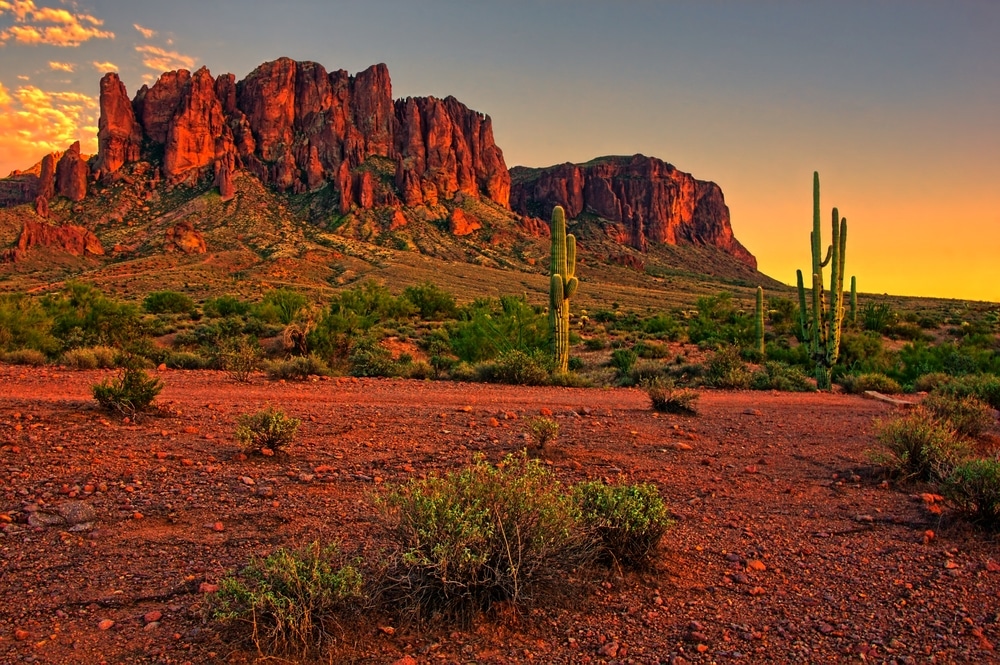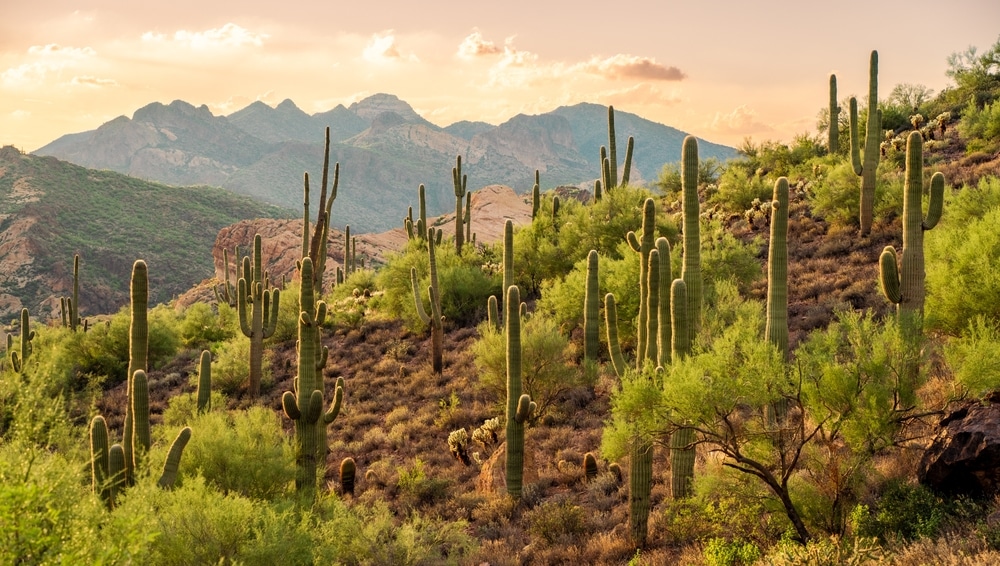Central Arizona stands as a testament to human ingenuity against the backdrop of stunning Sonoran Desert landscapes. This vibrant region stretches across the sun-drenched Valley of the Sun and encompasses metropolitan Phoenix and its surrounding communities, extending outward to where urban innovation gradually gives way to rugged desert wilderness. Defined by its dramatic mountain silhouettes, iconic saguaro cacti, and life-giving waterways including the Salt, Verde, and Gila Rivers, Central Arizona represents a dynamic blend of natural wonder and human achievement.
The story of this land began thousands of years ago with the Hohokam people, whose sophisticated canal systems first transformed the desert into agricultural prosperity. Their legacy lives on in both archaeological sites and modern water management practices. Spanish explorers arrived in the 16th century, followed by American pioneers who established farming settlements that would eventually grow into today’s bustling cities. The completion of Roosevelt Dam in 1911 marked a turning point, providing reliable water that catalyzed explosive growth throughout the 20th century.


Today’s Central Arizona has evolved far beyond its agricultural and mining roots into a diverse economic powerhouse, home to advanced manufacturing, technology firms, educational institutions, tourism destinations, and retirement communities. The region’s cultural identity reflects this layered history—where Native American heritage blends with Hispanic traditions, pioneer resilience, and contemporary Southwestern style to create communities that are distinctly Arizonan yet uniquely their own.
From the towering financial centers of Phoenix to historic small towns and master-planned communities, Central Arizona offers visitors an extraordinary range of experiences bound together by stunning desert scenery, innovative approaches to desert living, and warm hospitality regardless of which community you choose to explore.
Central Arizona’s landscape tells an ancient story written in stone and shaped by water and wind. The region is defined by striking mountain ranges that rise dramatically from the valley floor—South Mountain, the Superstitions, McDowell Mountains, White Tanks, and the iconic Camelback Mountain create the natural boundaries of this desert basin. These formations range from smooth, rounded granite formations to jagged volcanic remnants, each offering distinctive hiking trails and scenic vistas for outdoor enthusiasts.
The Sonoran Desert itself stands apart as the world’s most vibrant desert ecosystem, home to the iconic saguaro cactus that can live for 200 years and grow up to 60 feet tall. Unlike many deserts, the Sonoran thrives with biodiversity—from mesquite and palo verde trees to cholla and barrel cacti, creating microhabitats for roadrunners, javelina, coyotes, and numerous bird species that have adapted to desert life.
Water—rare yet transformative—has shaped Central Arizona’s most spectacular features. The Salt and Verde Rivers have carved dramatic canyons before feeding the region’s lakes and reservoirs. Human engineering has expanded these natural resources through impressive waterworks like the Central Arizona Project canal system and the region’s numerous lakes, including Saguaro, Canyon, Apache, and Roosevelt Lakes, which provide both crucial water resources and recreational opportunities.
Protected areas like the McDowell Sonoran Preserve, South Mountain Park (America’s largest municipal park), and the Superstition Wilderness allow visitors to experience pristine desert landscapes just minutes from urban centers—a juxtaposition that defines the Central Arizona experience.
Central Arizona’s rich historical tapestry begins with the ancient Hohokam civilization, whose sophisticated canal systems and desert farming practices supported large settlements from 300 BCE until about 1450 CE. Their legacy is visible today at sites like Pueblo Grande in Phoenix and Casa Grande Ruins National Monument, while their engineering genius lives on in the modern canal systems that follow many of the same routes.
The region’s Hispanic heritage dates to the 16th century when Spanish explorers first ventured into these territories. Later, Mexican ranchers established haciendas until American settlement intensified following the 1848 Treaty of Guadalupe Hidalgo. The discovery of gold in the Bradshaw Mountains and completion of the transcontinental railroad accelerated development, leading to Arizona’s statehood in 1912.
Military history runs deep with landmarks like Fort McDowell and Luke Air Force Base, while transportation corridors evolved from ancient Native American trading routes to Spanish trails, stagecoach lines, and eventually Route 66 and today’s interstate highways. Agricultural innovation transformed the region through the early 20th century, particularly after the Roosevelt Dam’s completion revolutionized water management.
Today, this layered heritage is celebrated through museums like the Heard Museum of Native American Art and Culture, the Arizona Heritage Center, and community events that honor diverse traditions—from Native American festivals to Hispanic celebrations like Dia de los Muertos. Historic districts in communities like Phoenix’s Heritage Square, Scottsdale’s Old Town, and Florence’s downtown preserve architecture that spans territorial days to mid-century modernism, offering visitors tangible connections to the past.
Central Arizona redefines outdoor recreation by offering extraordinary experiences that leverage the unique desert environment rather than despite it. Water activities provide welcome relief from desert temperatures at area lakes and rivers. Visitors can enjoy boating, kayaking, and fishing at Tempe Town Lake, the Salt River, Lake Pleasant, or any of the reservoir lakes along the Salt and Verde Rivers. The Lower Salt River offers refreshing tubing adventures during summer months, creating the surreal experience of floating through desert landscapes.
Land-based adventures capitalize on the region’s varied terrain. More than 1,000 miles of hiking trails crisscross Central Arizona, ranging from easy urban paths to challenging mountain ascents like Camelback Mountain and Piestewa Peak. Mountain biking enthusiasts find world-class trails in the McDowell Sonoran Preserve and South Mountain Park, while rock climbers test their skills on the region’s granite formations.
Golf reaches its pinnacle in Central Arizona, with over 200 courses that include both championship designs like TPC Scottsdale (home of the famous Phoenix Open) and affordable public options. Desert courses ingeniously incorporate native landscapes, creating playing experiences found nowhere else in the world.
For those seeking less strenuous experiences, scenic drives like the Apache Trail and botanical showcases like the Desert Botanical Garden demonstrate the Sonoran Desert’s surprising beauty. Wildlife viewing opportunities abound at preserves like the Riparian Preserve at Water Ranch in Gilbert, where desert and water ecosystems meet.
Seasonal considerations enhance the recreational experience—from spring wildflower blooms and fall hiking weather to summer stargazing and winter desert golf—ensuring that Central Arizona offers year-round outdoor enjoyment.
Central Arizona represents one of humanity’s most impressive examples of desert adaptation, where innovative approaches to water management, sustainable building, and agricultural science have created prosperity in an environment once considered too harsh for large-scale settlement.
The region’s agricultural success story begins with ancient Hohokam canals and continues today with sophisticated irrigation systems that support diverse crops—from traditional cotton and citrus to olive groves, date palms, and emerging wine industries in areas like Queen Creek. Visitors can experience this agricultural heritage through farmers markets and agritourism destinations that showcase desert farming techniques.
Water innovation defines Central Arizona’s development. The Salt River Project and Central Arizona Project represent engineering marvels that have transformed desert into oasis. Today, progressive water conservation programs and groundwater management practices are setting national standards for responsible desert living—visible in everything from desert-adapted landscaping to advanced water recycling facilities.
Renewable energy thrives in the Valley of the Sun, with solar installations increasingly common across the region. Research centers at Arizona State University pioneer sustainable technologies specifically designed for desert environments, while Taliesin West (Frank Lloyd Wright’s winter home) demonstrates how architectural design can work harmoniously with desert conditions.
Master-planned communities like Fountain Hills, Anthem, and Verrado showcase holistic approaches to desert development, balancing human needs with environmental sensitivity. Throughout Central Arizona, you’ll find communities embracing smart growth principles that honor the desert’s character while creating comfortable living environments—proving that innovation and respect for natural systems can coexist.
Central Arizona encompasses a mosaic of distinctive communities, each offering its own character while contributing to the region’s collective identity:
Phoenix, the nation’s fifth-largest city, serves as the metropolitan anchor with its dynamic downtown, cultural institutions, and diverse neighborhoods ranging from historic districts to modern urban developments.
Scottsdale blends sophisticated arts and shopping districts with rugged natural preserves and resort corridors, earning its reputation for both luxury and outdoor adventure.
Mesa, with its strong heritage and family-friendly attractions, represents the region’s agricultural roots while embracing educational innovation.
Chandler and Gilbert exemplify the region’s evolution from farming communities to technology hubs and family-centered suburbs with distinctive downtown districts.
Tempe pulses with collegiate energy around Arizona State University while offering urban outdoor experiences along Tempe Town Lake.
Glendale combines historic charm with modern sports venues, including State Farm Stadium, home to the Arizona Cardinals.
Surprise, Peoria, Goodyear, and Avondale in the West Valley balance residential growth with outdoor recreation and emerging employment centers.
Paradise Valley, Carefree, and Cave Creek offer distinctive luxury and western experiences nestled against mountain backdrops.
Apache Junction and Florence provide gateways to rugged adventures and historical exploration at the region’s eastern edge.
Queen Creek, Fountain Hills, El Mirage, Youngtown, Litchfield Park, Tolleson, Guadalupe, Buckeye, Eloy, and Maricopa each contribute unique historical narratives, cultural traditions, and community characters that reveal different facets of Central Arizona’s identity.
Each community invites deeper exploration through their individual pages, where you’ll discover local landmarks, signature events, and hidden gems that make Central Arizona an endlessly fascinating destination.
Central Arizona welcomes visitors year-round, though each season offers distinct advantages. October through April delivers perfect weather for outdoor exploration, with comfortable temperatures ideal for hiking, golfing, and desert exploration. Summer months (May through September) bring desert heat but reward visitors with dramatic monsoon storms, significantly lower hotel rates, excellent indoor attractions, and refreshing water activities.
The region’s extensive freeway system makes navigation straightforward, with Interstates 10 and 17 serving as major arteries. Most attractions are within a 45-minute drive of central Phoenix, making day trips easy from any accommodation base. Beyond personal vehicles, the Valley Metro light rail connects Phoenix, Tempe, and Mesa, while rideshare services operate throughout the region.
Visitors should consider these practical tips when planning:
Whether you’re planning a week-long exploration or a quick weekend getaway, Central Arizona offers efficient access to extraordinary diversity within a compact geographical area.
Central Arizona defies desert stereotypes at every turn—a place where modern cities rise from ancient landscapes, where water features punctuate arid terrain, and where cultural traditions blend to create distinctively Southwestern experiences unavailable anywhere else.
Only here can you:
The communities of Central Arizona invite you to dig deeper—to move beyond the section homepage and discover the specific characters, attractions, and stories that make each destination unique. Whether you’re drawn to outdoor adventure, cultural exploration, culinary experiences, or simply the magic of desert landscapes, the pages that follow will guide you to experiences that transform a visit into a journey of discovery.
In Central Arizona, the expected and unexpected coexist in perfect harmony, waiting for you to experience them firsthand.
We use cookies to improve your experience on our site. By using our site, you consent to cookies.
Manage your cookie preferences below:
Essential cookies enable basic functions and are necessary for the proper function of the website.
Statistics cookies collect information anonymously. This information helps us understand how visitors use our website.
Marketing cookies are used to follow visitors to websites. The intention is to show ads that are relevant and engaging to the individual user.